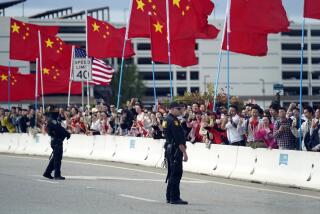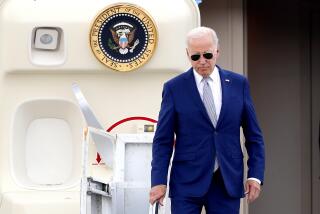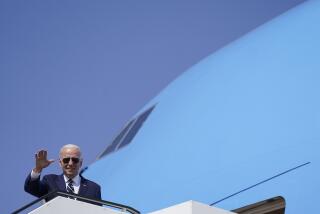Regional Outlook : Bush’s Tour Reflects New Realities in U.S.-Asia Ties : * Continuity, the planned message of the trip, is being overtaken by events.
WASHINGTON — When it was first planned earlier this year, President Bush’s voyage across the Pacific was intended to demonstrate the continuity and stability of America’s role in Asia.
Instead, ironically, Bush’s current expedition has turned into a dramatic illustration of how fast the ties between the United States and Asia are being transformed. In virtually every aspect of regional relations--economics, security and politics--old patterns and assumptions about the United States are being called into question. And discussions are peppered with ideas for new institutions to fill any regional void that might result from a changed American profile in Asia.
“Its (America’s) leadership role in the region’s economy and diplomacy can no longer be taken for granted,” observes Charles E. Morrison of the East-West Center in Honolulu.
For more than four decades, ever since the end of World War II, the United States served as the dominant non-Communist power in Asia, the nation that protected Japan and other capitalist nations in the region and helped guide them from poverty to economic prosperity.
Now, with the end of the Cold War, the Asian governments no longer need American protection so much, at least not against the Soviet Union. Japan is the region’s leading economic power. And Asians are finding that, increasingly, it is the once-awesome Americans who are asking them for economic help, rather than the other way around.
Look at some of the signs of change in the weeks leading up to Bush’s trip:
* The President’s explanation last month that his primary mission in Asia was to create “American jobs” and his decision to carry along an entourage of U.S. business executives shows that future U.S. foreign policy in Asia will stress trade and economic issues--just as Asian governments have done for years.
“You can call it a compliment. We’re going Asian,” says James Clad of the Carnegie Endowment for International Peace. “Imitation is the highest form of flattery.”
* Despite the Bush Administration’s efforts to put the best face on it, the recent announcement that the U.S. Navy will leave its century-old base at Subic Bay in the Philippines is the clearest indication yet that the American military presence in Asia is being scaled back.
* Finally, the Japanese Parliament’s refusal last month to approve legislation authorizing the use of Japanese troops overseas, even for peacekeeping missions, demonstrates that Tokyo will be more willing to go its own way and disregard what Washington wants.
The Bush Administration had been hoping for approval of this Japanese legislation for more than a year--ever since, in the aftermath of the Iraqi invasion of Kuwait, Japan declined to send personnel to take part in the multinational operations in the Persian Gulf.
To some extent, the changes symbolized by the Bush trip are the result of short-term domestic politics in the United States.
With the economy in recession, Bush knows his biggest vulnerabilities in the 1992 election year are on trade and economic issues and on his own admitted preference for foreign affairs over domestic policy.
“We’re going into a hell of a year over there (in the United States),” the President acknowledged last week on a jog in Sydney, Australia, on what was New Year’s Eve in America. “It’s politics--it’s politics from tomorrow on.”
Yet, in a larger sense, the changes in the Bush trip reflect long-range trends in Asia and the Pacific.
Take, for example, economics. The Bush Administration is not alone in giving greater importance than in the past to pocketbook issues. So is everyone else, including even the Vietnamese and the North Koreans.
“To an unprecedented extent, economics has taken command of international relations,” Robert A. Scalapino, an Asia scholar at UC Berkeley, wrote recently. “This was not always true.
“At the close of the Second World War, politics was generally paramount, especially in Asia, with revolutionary leaders seeking to build or rebuild nations by mobilizing their people through ideological appeals. . . . Today, however, even Leninist states are forced to concentrate on economic reform in an effort to compete with others.”
While American officials from Presidents and secretaries of state on down have pressed Japan, South Korea and other Asian governments before to open their markets to American products, there is a new sense of urgency in the question.
Over the past half-decade, American trade deficits with Europe have disappeared, while those with Japan have remained as large as ever. And now, Bush and the American executives in his delegation have made plain that they want much broader changes than have been offered so far.
“The Japanese must change their systems of competition and change . . . to bring them into material alignment in all respects with those in North America and those in Europe,” Joseph T. Gorman, chairman of TRW Inc., told reporters on the eve of the trip. “It is simply unacceptable to have one of the three major trading regions of the world with a different set or rules.”
Another change is the Bush Administration’s emphasis on the Western Hemisphere, illustrated by the proposed North American free trade agreement with Canada and Mexico.
Some American analysts believe that over the next decade, as Asia becomes more prosperous and its labor costs increase, American companies will begin to devote an ever-greater share of new investment capital to Latin America.
“We clearly have under way long-range changes in where the United States sources its manufacturers,” says Alan J. Stoga, an economist for Kissinger Associates, former Secretary of State Henry A. Kissinger’s consulting firm. “Trade relations between East Asia and the United States are going to atrophy over the next few years. That’s the direction of the economic trends, and the political trends reinforce that.”
In 1990, America’s two-way trade with Asia amounted to $310 billion, considerably higher than the $220 billion in U.S. trade with Europe. Some analysts believe American trade with Asia could be twice as high as its trade with Europe by the end of the decade.
Economists such as Stoga do not argue that the American trade with Asia will vanish. Rather, they believe that it will fail to grow as rapidly as it has in recent years. If so, intra-Asian trade--that is, trade among Asian countries--will take up an ever-increasing share of the growth in the Asian economy.
For their part, Asian leaders see both increased American interest in Western Hemisphere trade and differences over Washington’s demands that they open their own markets as threatening the basis of postwar U.S. relations with the region.
“Divisive economic frictions rather than common economic and security concerns now dominate much of the bilateral U.S. policy dialogue with the (Asia and Pacific) region,” says Morrison of the East-West Center.
Most of all, Asian leaders worry that over the next few years, the world may split up into three rival trading blocs: one for Europe, one for the Americas and one for Asia. Such a division might deprive Asian companies of their access to the American market, where they still sell more of their exports than anywhere else.
On the current trip, Bush is trying to give reassurances that this won’t happen.
“Does this mean we’re going to have one trading bloc in Europe and one trading bloc in America, and then somebody else look to some different kind of trading bloc in Asia and Australia?” he asked last week. “The answer to that is no. . . . We’re going to stay totally involved in this part of the world.”
There is every reason to think Bush is being sincere. After all, the Asian market is important to American exporters, just as America’s market is vital to Asia. A quarter of the world’s goods and services and 40% of the world’s people are in Asia.
Moreover, over the last three years, the Bush Administration has gone to considerable lengths to support the Asia-Pacific Economic Cooperation (APEC), a new regional economic organization whose membership includes the United States, Japan and 13 other nations on both sides of the Pacific. The Administration has strongly opposed the development of any intra-Asian trade group that excludes the United States.
It is not yet clear, however, whether APEC will evolve into much more than a powerless debating society. If the current world trade talks break down, and if Americans become convinced that trade with Asia is no longer what Bush called “a two-way street,” then some analysts fear a system of trade blocs could emerge no matter what Bush is now saying.
Similarly, on his current trip the President is trying to reassure Asian leaders that the United States plans to retain its role as the focus and dominant power in Asian security affairs.
“We are not, because of the closing of Subic, pulling back from future security considerations,” Bush declared last week. “We are a Pacific power. . . . Our military as well as our economic interests are still housed in the Pacific to a large degree.”
Nevertheless, the breakup of the Soviet Union has dramatically altered all security calculations for Asia and the Pacific. For four decades, the United States worked with Asian countries in military alliances, first against Communist expansion and then against Soviet military power.
What do the American troops protect now? Do they guard against an expansion of power by Japan, which remains America’s strongest ally in Asia? What happens when, say, South Korea has the ability to protect itself without American troops, and decides it no longer wants them there?
For that matter, what happens when the United States decides it no longer needs or can afford the sort of military presence in Asia that it has had over the past decades? There have been already hints that this is what prompted the Americans to agree to leave Subic Bay in the Philippines; in the end, the U.S. Navy may have decided that the once-prized base is no longer worth the money and political hassle.
So far, the Bush Administration has not been able to come up with any new rationale for maintaining troops throughout the Pacific.
“New ideas relating to American security policies in Asia have not been forthcoming from Washington,” wrote Scalapino in a recent edition of Foreign Affairs magazine. “On the contrary, the present line is that the United States should pursue the same course, except at the reduced level necessitated by budget cuts.”
Over the last three years, a number of Pacific Rim countries, including Australia and Canada, have suggested the formation of some new security organization for Asia, similar to the Conference for Security and Cooperation in Europe (CSCE).
But the Bush Administration has strongly opposed the creation of anything new on grounds that existing alliances already provide all the security needed. “The United States . . . has been the balancing wheel of an informal, yet highly effective security structure for more than four decades,” Undersecretary of State Robert B. Zoellick said at a conference in Malaysia last summer.
Despite the lack of support from the United States, Japan proposed last summer that Asian officials gather regularly for talks about security at the annual meeting of the Assn. of Southeast Asian States. So far, other Asian countries have not yet decided whether to go along with Japan’s suggestion.
By failing last month to approve the use of its troops for international peacekeeping operations, Japan made clear that there is still no way out of the security conundrum faced during the Gulf War.
American troops protect Persian Gulf oil and Asian sea lanes, while Japan after much prodding agrees to help pay for the American operations. Both countries are unhappy with this situation. Secretary of State James A. Baker III last November warned Japan against engaging in what he called “checkbook diplomacy.” Japanese officials, meanwhile, complain that they are being dunned for American foreign policy and military decisions over which they have no say.
Speaking of Japan’s role in the Gulf War, Yoichi Funabashi, diplomatic correspondent for the Asahi Shimbun, recently wrote: “In the moment of truth, an economic superpower found itself merely an automatic teller machine--one that needed a kick before dispensing the cash.”
The World’s Major Traders
Country: Total 1990 Trade Share of 1990 (in billions of World Trade U.S. dollars) (percentage) United States (*) 902.3 13.3 Germany 717.0 10.6 Japan (*) 520.7 7.7 France 446.7 6.6 Britain 376.7 5.6 Other Asia-Pacific Countries: Canada (*) 246.5 3.6 China (*) 137.3 2.0 Hong Kong (*) 132.0 1.9 Taiwan (*) 118.9 1.8 South Korea (*) 117.6 1.7 Singapore (**) 99.6 1.5 Australia (*) 80.7 1.2 Malaysia (**) 59.6 0.9 Thailand (**) 54.4 0.8 Indonesia (**) 45.0 0.7 Philippines (**) 23.1 0.3 New Zealand (*) 18.2 0.3 Brunei (**) NA NA ASEAN Total 281.7 4.2 APEC Total 2,555.9 37.8 World Total 6,774.8 100.0
* = Member of Asia-Pacific Economic Cooperation group (APEC) ** = Member of both APEC and Association of Southeast Asian Nations (ASEAN) Sources: International Monetary Fund “Direction of Trade Statistics;” Business International.
More to Read
Sign up for Essential California
The most important California stories and recommendations in your inbox every morning.
You may occasionally receive promotional content from the Los Angeles Times.










